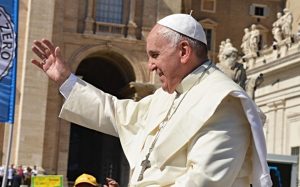
Pope Francis to fly across world to visit Mongolia’s tiny Catholic flock
VATICAN CITY/ULAANBAATAR — Mongolia’s Catholics — all 1,450 of them – could be squeezed standing into St. Peter’s Basilica dozens of times over and their number is smaller than the congregation of a small parish in some small towns.
So why is Pope Francis, 86 and in need of a wheelchair, traveling 8,278 kilometers to visit them this week?
Essentially, to paraphrase British climber George Mallory’s response in the 1920s as to why he wanted to climb Mt. Everest, because the Catholics are there.
“I can’t even fathom this,” said Arvanai Hashdorj, 19, a university student who attended Mass on Sunday at the Cathedral of Saints Peter and Paul in the Mongolian capital Ulaanbaatar on Sunday. “So I am very grateful”.
Mr. Hashdorj told Reuters he had recently returned from the Catholic Church’s World Youth Day gathering in Lisbon, where young people from countries with millions of Catholics noted in conversations with him that the pope had not yet visited their countries.
Visiting places where Catholics are a minority is part of Francis’ policy of drawing attention to people and problems in what he has called the peripheries of society and of the world.
He still has not visited most of the capitals of Western Europe.
Pope Francis, who will be attending an inter-religious service in Mongolia, said at his weekly noon address on Sunday that he would be visiting “a Church that is small in numbers but vivacious in faith”.
Last year, Francis named Archbishop Giorgio Marengo, an Italian, the first cardinal to be based in Mongolia, where he is the Catholic Church’s administrator.
“The originality of this trip is related to the originality of the country sparsely populated and with such a small Catholic community,” Marengo said last month in Rome.
“This shows how for him (the pope), every single member of the faithful is important,” said Mr. Marengo, who has been a missionary in Mongolia for more than 20 years.
Mongolia has nine parishes, compared to 25,500 in Italy. The smallest one, hundreds of miles from the capital, has only between 30-40 members.
Still, the visit will show how far it has come since locals watched “these funny foreigners praying,” Mr. Marengo said.
‘GREAT RELIGIOUS TRADITION’
Francis said on Sunday that he felt honoured to visit “a noble and wise people” with a “great religious tradition”.
About 60% of Mongolians identify as religious. Among those, 87.1% are Buddhist, 5.4% Muslim, 4.2% Shamanist, 2.2% Christian and 1.1% followers of other religions, according to the US State Department.
There are only two native Mongolian Catholic priests.
“I wanted to show the world that there is a Catholic Church (in Mongolia) and it’s beautiful,” said one of them, Father Peter Sanjaajav, after saying Mass at the Cathedral the pope will visit on Saturday as part of the Aug. 31-Sept 4 trip.
The country of about 3.3 million people is strategically significant for the Roman Catholic Church because of its proximity to China, where the Vatican is trying to improve the situation of Catholics amid sometimes scratchy relations with the communist government.
Mongolia was part of China until 1921 and still has close ties with Beijing. Diplomats say it could be used as an intermediary with China.
It was not clear if any Catholics from China would be allowed to cross the border to see the pope.
China is by far Mongolia’s biggest export market, buying most of its coal, copper and cashmere, and Ulaanbaatar also relies on China’s rail network to deliver its goods to third countries.
Mongolia has seen a revival of Tibetan Buddhism since the collapse of the Soviet-backed Communist government in 1990, and the Dalai Lama is regarded as its main spiritual leader.
However, China has repeatedly put pressure on Mongolia not to allow the 88-year old exiled Tibetan leader to visit, branding him a dangerous separatist. — Reuters
